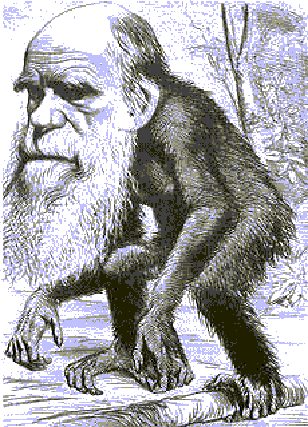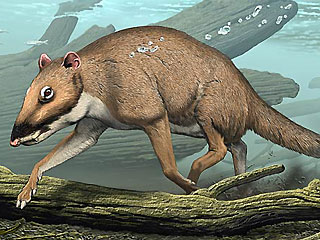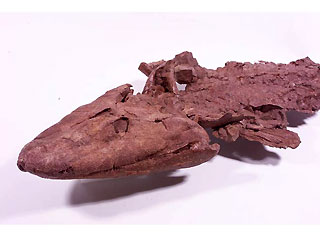‘Missing Links’ Reveal Truth About Evolution
Posted by tothewire on February 12, 2009

With the 200th anniversary of the birth of Charles Darwin this week, people around the world are celebrating his role as the father of evolutionary theory.
Events and press releases are geared, in part, to combat false claims made by some who would discredit the theory.
One frequently cited “hole” in the theory: Creationists claim there are no transitional fossils, aka “missing links.”
Biologists and paleontologists, among others, know this claim is false.
As key evidence for evolution and species’ gradual change over time, transitional creatures should resemble intermediate species, having skeletal and other body features in common with two distinct groups of animals, such as reptiles and mammals, or fish and amphibians.

The ancient elephant Moeritherium, as imagined by German naturalist painter Heinrich Harder around 1920.
These animals sound wild, but the fossil record — which is far from complete — is full of them nonetheless, as documented by Occidental College geologist Donald Prothero in his book “Evolution: What the Fossils Say and Why It Matters” (Columbia University Press, 2007).
Prothero discussed those fossils last month at the American Museum of Natural History in New York, along with transitional fossils that were announced since the book was published, including the “fishibian” and the “frogamander.”

Indohyus, a possible ancestor of whales that swam in shallow water 48 million years ago in what's now India.
At least hundreds, possibly thousands, of transitional fossils have been found so far by researchers. The exact count is unclear because some lineages of organisms are continuously evolving.
Here is a short list of transitional fossils documented by Prothero and that add to the mountain of evidence for Charles Darwin’s theory.
A lot of us relate most to fossils of life closely related to humans, so the list focuses on mammals and other vertebrates, including dinosaurs.
Mammals, including us
— It is now clear that the evolutionary tree for early and modern humans looks more like a bush than the line represented in cartoons.
All the hominid fossils found to date form a complex nexus of specimens, Prothero says, but Sahelanthropus tchadensis, found in 2001 and 2002, threw everyone for a loop because it walked upright 7 million years ago on two feet but is quite chimp-like in its skull size, teeth, brow ridges and face.
It could be a common ancestor of humans and chimpanzees, but many paleoanthropologists will remain unsure until more fossils are found. Previously, the earliest ancestor of our Homo genus found in the fossil record dated back 6 million years.

Tiktaalik, an intermediate form between fish and amphibians that lived 375 million years ago.
— Most fossil giraffes have short necks and today’s have long necks, but anatomist Nikos Solounias of the New York Institute of Technology’s New York College of Osteopathic Medicine is preparing a description of a giraffe fossil, Bohlinia, with a neck that is intermediate in length.
— Manatees, also called sea cows, are marine mammals that have flippers and a down-turned snout for grazing in warm shallow waters.
In 2001, scientists discovered the fossil of a “walking manatee,” Pezosiren portelli, which had feet rather than flippers and walked on land during the Eocene epoch (54.8 million years ago to 33.7 million years ago) in what is now Jamaica.
Along with skull features like manatees (such as horizontal tooth replacement, like a conveyor belt), it also had heavy ribs for ballast, showing that it also had an aquatic lifestyle, like hippos.
— Scientists know that mastodons, mammoths and elephants all share a common ancestor, but it gets hard to tell apart some of the earliest members of this group, called proboscideans, going back to fossils from the Oligocene epoch (33.7 million years ago to 23.8 million years ago).
The primitive members of this group can be traced back to what Prothero calls “the ultimate transitional fossil,” Moeritherium, from the late Eocene of Egypt.
It looked more like a small hippo than an elephant and probably lacked a long trunk, but it had short upper and lower tusks, the teeth of a primitive mastodon and ear features found only in other proboscideans.
— The Dimetrodon was a big predatory reptile with a tail and a large sail or fin-back. It is often mistaken for a dinosaur, but it’s actually part of our mammalian lineage and more closely related to mammals than reptiles, which is seen in its specialized teeth for stabbing meat and skull features that only mammals and their ancestors had. It probably moved around like a lizard and had a jawbone made of multiple bones, like a reptile.
Dinosaurs and birds
— The classic fossil of Archaeopteryx, sometimes called the first bird, has a wishbone (fully fused clavicle) which is only found in modern birds and some dinosaurs. But it also shows impressions from feathers on its body, as seen on many of the theropod dinosaurs from which it evolved.
Its body, capable of flight or gliding, also had many of dinosaur features — teeth (no birds alive today have teeth), a long bony tail (tails on modern birds are entirely feathers, not bony), long hind legs and toes, and a specialized hand with long bony fingers (unlike modern bird wings in which the fingers are fused into a single element), Prothero said.
— Sinornis was a bird that also has long bony fingers and teeth, like those seen in dinosaurs and not seen in modern birds.
— Yinlong is a small bipedal dinosaur which shares features with two groups of dinosaurs known to many kids — ceratopsians, the beaked dinosaurs like Triceratops, and pachycephalosaurs, known for having a thick dome of bone in their skulls protecting their brains. Yinlong has the thick rostral bone that is otherwise unique to ceratopsians dinosaurs, and the thick skull roof found in the pachycephalosaurs.
— Anchisaurus is a primitive sauropod dinosaur that has a lot of lizard-like features. It was only 8 feet long (the classic sauropods later on could be more than 100-feet long), had a short neck (sauropods are known for their long necks, while lizards are not), and delicate limbs and feet, unlike dinosaurs. Its spine was like that of a sauropod.
The early sauropods were bipedal, while the latter were stood on all fours. Anchisaurus was probably capable of both stances, Prothero wrote.
Fish, frogs, reptiles
— Tiktaalik, aka the fishibian or the fishapod, is a large scaled fish that shows a perfect transition between fins and feet, aquatic and land animals.
It had fish-like scales, as well as fish-like fin rays and jaw and mouth elements, but it had a shortened skull roof and mobile neck to catch prey, an ear that could hear in both land and water, and a wrist joint that is like those seen in land animals.
— Last year, scientists announced the discovery of Gerobatrachus hottorni, aka the frogamander. Technically, it’s a toothed amphibian, but it shows the common origins of frogs and salamanders, scientists say, with a wide skull and large ear drum (like frogs) and two fused ankle bones as seen in salamanders.
— A turtle on the way to becoming a turtle, Odontochelys semistestacea, swam around in China’s coastal waters 200 million years ago. It had a belly shell, but its back was basically bare of armor. Odontochelys had an elongated, pointed snout. Most modern turtles have short snouts.
In addition, the roof of its mouth, along with the upper and lower jaws, was equipped with teeth, which the researchers said is a primitive feature for turtles whose mugs are now tipped with beaks but contain no teeth.
By Robin Lloyd
lawman2 said
guess you just had to post this one,huh? good post,great read.blablabla
LikeLike
lawman2 said
you put a big smile on my face!
LikeLike
lawman2 said
don’t worry baby i would rather stand beside you than behind you…
LikeLike
dorian9 said
just what this nerdita likes to read! we need to discover more “transitional fossils” for us homo erecti. gotta keep digging! thanks ttw.
LikeLike
tothewire said
You’re welcome! I was hoping everyone would enjoy the read! I knew Lawman would, he loves science!
LikeLike
tothewire said
You inspired me Dorian! lol
LikeLike
tothewire said
I miss everyone! E_E and OTA haven’t been posting… hope everything is okay. Maybe they are busy in school.
LikeLike
kay~ms said
I just had a thought… in the process of evolution… when does it stop? What will we (humans?) be like a million years from now? I believe this theory is true but it’s been blown way out of proportion… we didn’t evolve from apes… and this STILL leaves the question of how existence began…
Reading this article reminds me of the ‘experts’ who once believed /insisted that when dogs waged their tails it was just a ‘reflex’ reaction… it had nothing to do with emotion… scientists are WRONG all the time.
Found an interesting counter point here…
THE CASE OF THE MISSING LINK
Where are Darwin’s predicted fossils?
http://www.knowgodpersonally.org/page.php?page=WhereAreDarwinsPredictedFossils
LikeLike
tothewire said
I will check that out in the morning with a nice hot cup of coffee Kay! You know I love a great read!
LikeLike
kay~ms said
Good idea TTW… it’s a pretty long article!
I noticed that the link doesn’t work so I just went ahead and posted it….
LikeLike
SewDucky said
My dad should have been a scientist, and I’m not kidding. We just had a discussion on this yesterday. One of the things I pointed out (I wanted to be a chemist for 15 years until they made me kill a gerbil, so yeah, I’m a nerd too) was that look at my dad, me and my son. Dad is nearly 70 and struggles with concepts of computers that I take for granted. He can, and does, use a computer, but it’s harder for him then it is for me. Simple concepts of even a virus scan takes 10 minutes of explaining the basics to it for him. I’m in my 30’s, am comfortable on a computer, understand some of the intricate ideas, and my nearly 10 year old can go in and change things on OS and it not fail, and does things I never would have thought of, and seems to have an inherent grasp of the concepts. While not “evolution” on Darwin’s scale, it’s still a technological evolution of sorts.
We’re all also left handed, and mentioned only because when we all work on things, Dad is very capable and can use both hands (and does) but it’s awkward and not as neat as with his left, but I can saw/screw/hammer with my right hand nearly as well as I can my left, maybe 1 in 10 of what I do with my right hand is slightly off. I had to learn and practice this for much of my youth and adolescence to be as dexterous as I am. Kid…it’s nearly natural for him. It’s almost a trained evolution there: Daddy made me use it younger then he did, and I practiced more, and because of that, I started making MY son use his right hand at a younger age. (To be honest tho, if you’re left handed, you do it almost out of self-defense, there is a lot of things using your left hand you’ll break or it won’t go in right and ruin it, on things like cars.)
Granted this isn’t high on the evolution scale, but it’s still a mild example.
LikeLike
tothewire said
I think Kay. I’ll change it.
LikeLike
tothewire said
Lawman you post things under my name all the time by the way…
LikeLike
tothewire said
OOPS! posted those last two comments on the wrong page!
Sewducky! Lawman is a lefty and so am I, guess our children won’t have a chance! Lawman always say’s lefty’s are special and smarter than the average cavedwellers…lol
I don’t know about that! BUT I do agree with you, we do tend to use both left and right at a young age. Lawman can write with both hands really quite well. I have to slow down and think about it, but can do it.
I bat left handed, or right. Confuses the pitcher! I love softball! lol
LikeLike
Anonymous said
it’s a right-handed world and lefties get a taste of being “different”, having to adjust more motor skills-wise brain-wise perhaps, as they naturally tend to go to their dominant side first. i think it’s great that most lefties learn to be ambidextrous. lots of advantages, esp. in sports.
i’m a righty bt taught myself to write with my left hand too as a kid because i thought lefties were different and cool! watch out lawman the bat can come at you from either side hehe
LikeLike
dorian9 said
i must wannabe anonymous. i promise to leave a note on my computers to log in before commenting ok?
LikeLike
SewDucky said
For me, it was normal since I was around it all the time. I ate dinner on the side with my brother who is also left handed and when my Dad was home (he was a truck driver) he was on the other side of me. My brother taught me to tie my shoes, and all the other things lefties do backwards (and which I still do backwards) and my dad changed the cabinet on my closet shelf (which had a door) and my toybox to opening in reverse, so much of it was just how it was. I adjust for the kid too, because it IS more convenient.
As to sports: I generally bat right handed because I used to get hit by pitchers and it was self-defense again but when I bat left handed, I can hit the pitcher or any other player on the field. Usually in the head. Volleyball, basketball, football (yes I learned because I was a single mom, the rest was because I played) and hockey doesn’t exactly matter which hand I favor.
The only thing I have ever had problems with being left handed was learning to crochet. I flat cannot do it. I know how, but something from the hook to the thread doesn’t translate well. Even knitting I do differently then most (I naturally learned the continental style) and my tension is, to coin the phrase of the old lady when I lived in Boston, wicked tight.
LikeLike
Buck Fulcher said
fast site
LikeLike